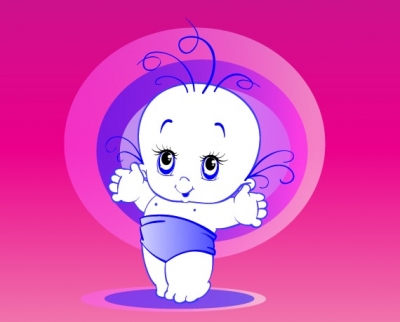Right from birth, babies explore the world around them and slowly begin to reach out to objects and try to grab them. Their eyes and visual system aren't fully developed. Babies have not yet developed the ability to easily tell the difference between two targets or move their eyes between the two images. Their primary focus is on objects 8 to 10 inches from their face or the distance to parent's face. During the first eight weeks, the eyes start working together and vision rapidly improves. Talk to them and bring your face close to them when you talk. The infant starts tracking moving objects with his or her eyes and begins to reach for it. Slowly they begin to focus on the face. Move the face away and track if the baby follows the face.
Their eyes are constantly providing them with information about the objects around them. This information and stimulation is necessary for their development. Healthy eyes and good vision play a critical role in how infants and children learn to see. Eye and vision problems in infants can cause developmental delays. It is important to detect any problems early to ensure babies have the opportunity to develop the visual abilities they need to grow and learn.
Parents play an important role in helping to assure their child's eyes and vision can develop properly. Some steps that can be taken by parents -
- Watching for signs of eye and vision problems.
- Seeking professional eye care starting with the first comprehensive vision assessment at about 6 months of age.
- Helping their child develop his or her vision by engaging in age-appropriate activities.
For the first two months of life, an infant's eyes are not well coordinated and may appear to wander or to be crossed. This is usually normal. However, if an eye appears to turn in or out constantly, an evaluation is warranted. By about three months the babies should begin to follow objects and start reaching out to it too. From the fifth month onwards the depth perception of the eyes begins to improve. Babies are able to control their eye movements better and would be able to judge if the objects are near or far away. Babies tend to have a good color vision by five months of age.
Most babies start crawling at about 8 months old, which helps further develop eye-hand-foot-body coordination. Researchers say that - Parents should encourage crawling rather than early walking to help the child develop better eye-hand coordination. By two years of age, a child's eye-hand coordination and depth perception should be well developed. Children are very inquisitive at this age and would like to explore their environment. They may be able to recognize familiar objects and pictures around them and from books. Read for them and say things loud. This helps in associating the picture with the word for the infant.
Eye problems in infants - The presence of eye and vision problems in infants is rare. Most babies begin life with healthy eyes and begin to develop their visual abilities and sense of objects slowly. But occasionally, eye health and vision problems can develop. Some signs and symptoms of eye problems -
Excessive tearing - this may indicate blocked tear ducts
Redness in the eyes and encrusted eyelids - this could be a sign of an eye infection
Constant turning of the eyes - this may signal a problem with eye muscle control
Extreme sensitivity to light - this may indicate an elevated pressure in the eye
The appearance of a white pupil - this may indicate the presence of an eye cancer
If you see any of the above symptoms or signs in the child please see an ophthalmologist and get the baby checked.
There are many things parents can do to help their baby's vision develop properly. The following are some examples of age-appropriate activities that can assist an infant's visual development.
Birth to four months
Change the baby’s position frequently
Keep reach-and-touch toys within your baby's focus, about eight to twelve inches.
Talk to your baby as you walk around the room.
Babies love to play with your face, talk to them and let them figure out your face.
Five to eight months
- Put various objects that interest the child for the baby to pull and kick
- Give the baby plenty of time to play and explore on the floor.
- Provide plastic or wooden blocks that can be held in the hands.
Nine to twelve months
- Play hide and seek games with toys or your face to help the baby develop visual memory.
- Name objects when talking, or reading a book and showing the pictures. This encourages the baby's word association and vocabulary development skills.
- Encourage crawling and creeping.
One to two years

